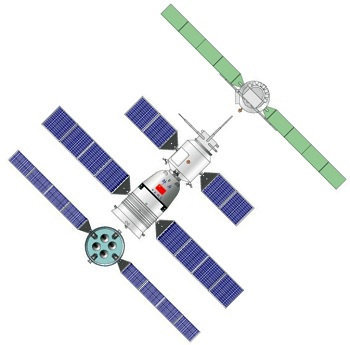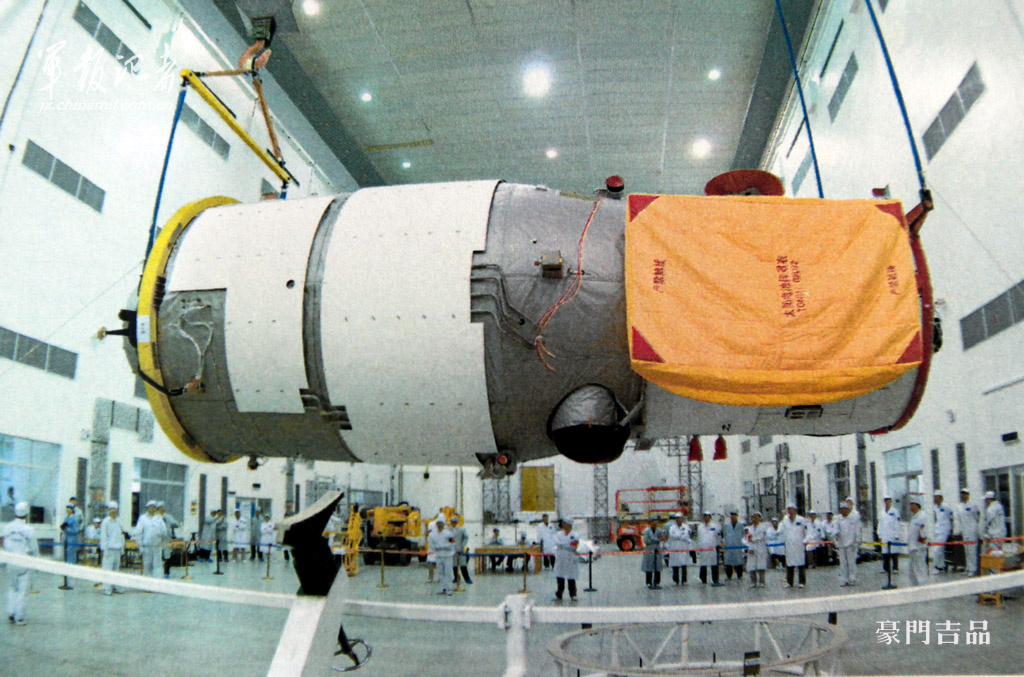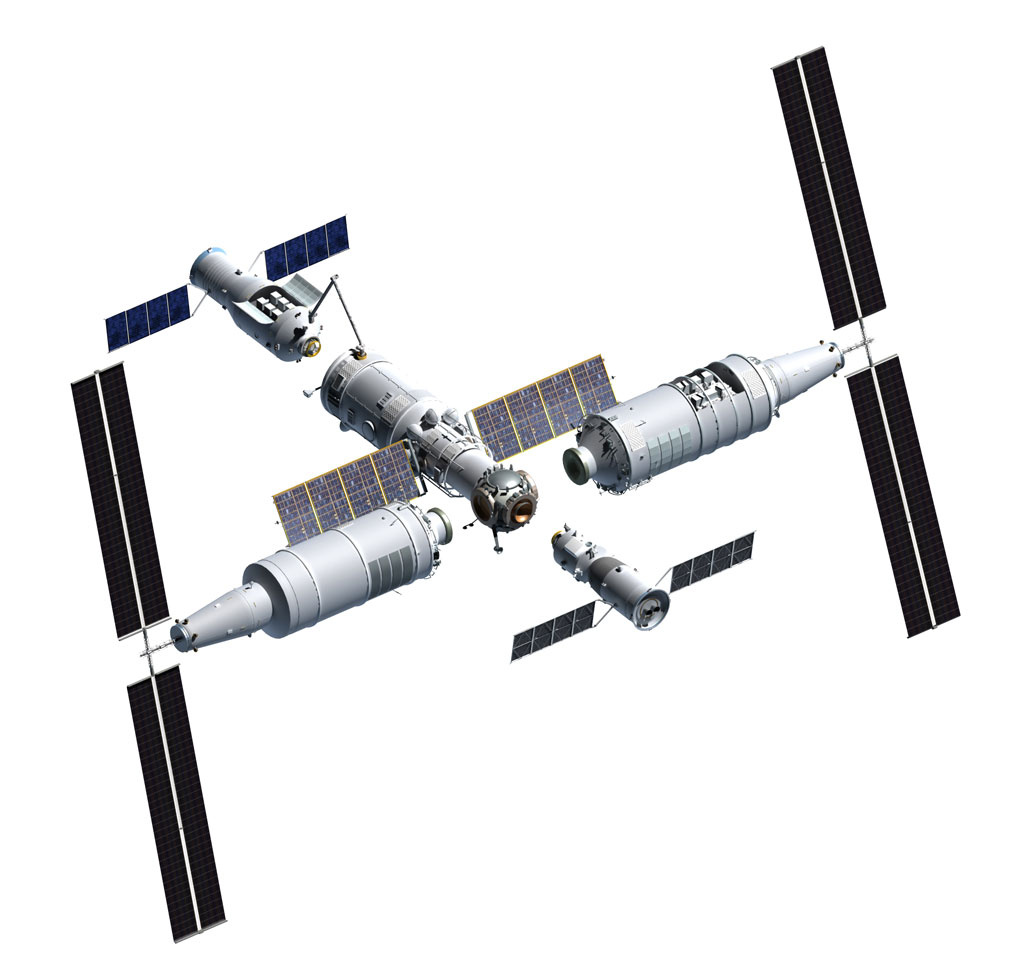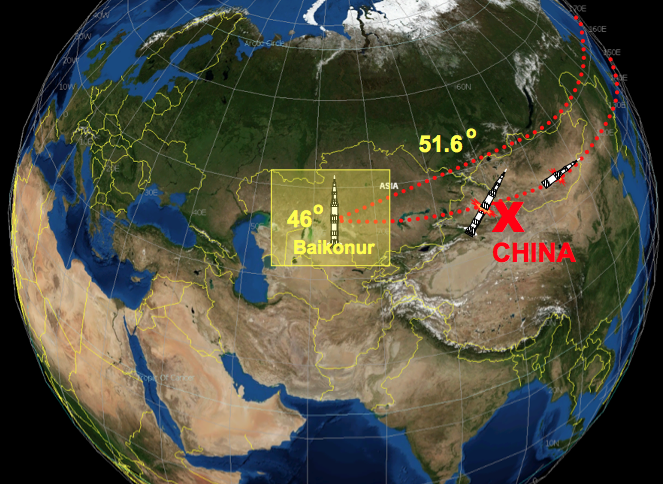 Bisbos.com
Bisbos.comAt the Paris Air Show at Le Bourget that is taking place these days, Chinese representatives offered Roscosmos to participate in the project of the Chinese space station. As the head of the state corporation, Igor Komarov, stated, there is no any agreement and plans: the stations have a different inclination of the orbit. So far, Russia has
no plans to join the project.
The station plan in question is relatively finalized. The manned Chinese space program itself is young - the first Chinese Taikunavt appeared less than a decade and a half ago. However, after the closure of the ISS project in the 20s of this century, the PRC may turn out to be one - if not the only - of the countries with a functioning station in Earth orbit.
MKS Closed Club
The existing
International Space Station is a merger of the
Freedom station project, the US orbital home and their Japanese, Canadian and European partners, and the Soviet
Mir-2 .
Both projects stretch almost half a century ago into the past of the Cold War. Plans for an international multi-module space station called Freedom (Freedom) were voiced in 1984 under Reagan. The 40th President in the United States inherited from its predecessor one of the most expensive orbital carriers in the history of the Space Shuttle and not a single permanent orbital station, and the new leadership in the United States always
likes to assign new directions to astronautics .
In a
speech on January 25, 1984, Reagan outlined the main characteristics of the Soviet “Peace” response: conducting research in microgravity conditions, the participation of allied countries, which both will help in the creation of the station, will also use it.

The illustration above in the artist’s presentation depicts one of the Freedom configurations. This is chosen on purpose - it is most reminiscent of the ISS. Some of them were larger and obviously more expensive. Meanwhile, the project received weak financial support. From 1984 to 1993, Freedom reworked plans seven times. Once in the US Congress, the station almost completely deleted from NASA's funding plan: only one vote was missing.
On the other side of the ocean, the economic situation was no better. In the gradually collapsing USSR, individual republics stopped transferring money to the federal budget, after the actual collapse, well-known processes of transition to new economic principles took place. There was even less money for space.
 One of the sketches of "World-2"
One of the sketches of "World-2"Fortunately, Mir-2 did not remain just an orbiter simulator's fantasy: through the
PMA-1 adapter, the
Zarya modules and the Mira-2 base unit, which became the
Star , were connected to the US segment.
For eighteen years in orbit, the ISS has gained its present scope. The station, which has become one of the most expensive structures of mankind, was visited by citizens of several dozen states, many countries are conducting experiments on it - you just need to be a partner.
But only the USA, their allies and Russia that joined the project have membership in the project. It does not participate in the ISS along with the rest, for example, India or South Korea. Other countries have real barriers to participation. Most likely, not a single citizen of the People's Republic of China will ever go aboard the station. The likely reason for this is geopolitical motives and political hostility. For example, all researchers at NASA’s US Space Agency are
forbidden to work with Chinese citizens associated with Chinese public or private organizations.
Fast start
Therefore, in space, China is walking alone. It seems that it has always been this way: the
Soviet-Chinese schism interfered with borrowing the experience of early Soviet launches. All that China had before him - to learn from the experience in creating the
R-2 rocket, an improved copy of the German
V-2 . In the seventies and eighties of the last century, in the framework of the
Intercosmos program , the USSR launched into orbit citizens of friendly states. And there was not a single Chinese. Technological exchanges between China and Russia
resumed only by the two thousandth.

The first Tycunaut appeared in 2003. The
Shenzhou-5 spacecraft put
Yang Liwei into orbit. Let and where much later, but China became the third nation in the world after the USSR and the USA, which created the possibility of a person being placed into Earth orbit. The answer to the question of how independently this work was carried out is the lot of fans to argue. But the ship "Shenzhou" both externally and internally resembles the Soviet "Union", and one of the world-famous Russian scientists
received 11 years of imprisonment on charges of transferring space technology to China.
in 2008, the PRC worked out a spacewalk at the
Shenzhou-7 . Zhay Zhigang, a
Taikunavta suit, was defended from the space of the
Taikunavta , created in the likeness of the Russian Orlan-M.

China launched its first space station, Tyangun
-1 , into orbit in 2011. Externally, the station resembles the early devices of the
Salyut series: it consisted of one module and did not provide for the expansion or docking of more than one ship. The station arrived at a given orbit. A month later, the Shenzhou-8 unmanned spacecraft was docked automatically. The ship undocked and docked again to test the rendezvous and docking systems. In the summer of 2012, "Tyangun-1" was visited by two crews of Taikunauts.
 " Tyangun-1 "
" Tyangun-1 "In world history, the launch of man is 1961, the exit into space is 1965, the automatic docking is 1967, the docking with the space station is 1971. China rapidly repeated the space records that the USA and the USSR set generations ago, he increased experience and technology, even resorting to copying.
Visits to the first Chinese space station did not last long, just a few days. As you can see, it was not quite a full-fledged station - it was created to work out technologies of rendezvous and docking. Two crews - and they left her.
At the moment, "Tyangun-1" is gradually descending from orbit, the remains of the apparatus will fall to Earth somewhere
in the end of 2017 . Probably, it will be an uncontrolled gathering, since
communication with the station is
lost .
Single modular "Tyangun
-2 " looks like its predecessor. This is again not a full-fledged station, but a visited module for testing technologies. The goals are now more important: working out life support systems, air regeneration, and no attempts at conducting scientific work.
For the first time, the
Tianzhou unmanned cargo spacecraft arrived at the Chinese station. The supply of stations by unmanned "trucks" is a key component of the continuous and long-term stay of people on board, as the
Salyut-6 station program demonstrated. The
Tiangong-3 station in China was decided to be abandoned, and the second “heavenly palace” assumed its goals.
Full station
Rapid development of technology is needed to launch a
Chinese multi-module space station . According to current plans, its mass will be 60 tons - the sixth part of the mass of the ISS or half the mass of the "World" in its final configuration.
The set of modules of the Chinese space station is roughly known. This is the basic module "Tianhe" ("Milky Way") and two scientific modules "Wentian" ("Questioning to the sky") and "Mentian" ("The sky of a dream"). It is noticeable that in the names of space vehicles, the Chinese adhere to poetic images, and not what one would expect from a communist country — the ideas of the world revolution of the proletariat. For this tradition, you need to thank the Chinese politician
Deng Xiaoping .
 Basic module " Tianhe "
Basic module " Tianhe "In the design of the 22-ton “Tianhe” there are noticeable similarities with the base module of the “World” and “Star” of the ISS, which are derived from the “Salyut”. A docking station is located in front of the module, a robotic manipulator, gyrodynes and solar panels are located outside. Inside the module there is a storage area for supplies and scientific experiments. The crew of the module - 3 people.
 Scientific module " Wentian "
Scientific module " Wentian "Two scientific modules will have approximately the same size as the "Tianhe", about the same weight - 20 tons. At Wentian, they want to put another smaller smaller robot-manipulator for experiments in outer space and a small airlock.
 Scientific module " Mentian "
Scientific module " Mentian "In "Mantyane" there is a gateway for a spacewalk and an additional docking station.
 Due to the scarcity of available information, the illustration of Bisbos.com allows freedom in assumptions and guesses, but gives a good idea of the future station. Here, in addition to the station modules, there is a cargo ship of the Tianzhou model (in the upper left corner) and the crew ship of the Shenzhou series (in the lower right corner).
Due to the scarcity of available information, the illustration of Bisbos.com allows freedom in assumptions and guesses, but gives a good idea of the future station. Here, in addition to the station modules, there is a cargo ship of the Tianzhou model (in the upper left corner) and the crew ship of the Shenzhou series (in the lower right corner).The
launch of the first modules
will begin in 2019, China plans to complete the assembly in 2022. The planned service life of a multi-module Chinese station is 10 years.
After ISS
Sooner or later, the ISS will serve its own. The current planned period is 2024. What to do after this?
Roscosmos wants to supplement the modules of the Russian segment of the ISS and create a new
national station . In May of this year, Russian Deputy Prime Minister Dmitry Rogozin
instructed Roscosmos to work out the issue of creating a station together with the
BRICS countries .
Perhaps these plans could be combined with the Chinese project. But on June 19, the head of Roscosmos, Igor Komarov,
said that for now there are no such plans:
They offered, we exchange offers to participate in projects, but they have a different mood, a different orbit, and plans that are somewhat different from us. While arrangements and plans for the future, there is nothing concrete.
He
recalled that the project of the Chinese space station is a national project, although other countries may participate in it. On the other hand, Xu Yansong, director of the international cooperation department of the China National Space Administration (CNSA), told RIA Novosti representatives that the project could become international.
The given problem in the location of the station is the inclination, one of the most important characteristics of the orbit of any satellite. This is the angle between the plane of the orbit and the plane of reference - in this case, the equator of the Earth.

The inclination of the International Space Station is 51.6 °, which is in itself curious. The fact is that when launching an artificial satellite of the Earth, it is most economical to add the speed that the rotation of the planet gives, that is, to launch with an inclination equal to latitude. The latitude of Cape Canaveral in the USA, where the launch pad sites are located, is 28 °, and Baikonur is 46 °. Therefore, when choosing a configuration, a concession was made to one of the parties. In addition, with the resulting station, you can take pictures of much more land. From Baikonur, they usually launch with an inclination of 51.6 ° so that the spent stages and the rocket itself in the event of an accident do not fall on the territory of Mongolia or China.
Russian modules separated from the ISS will retain an orbital inclination of 51.6 °, unless, of course, it is changed, which is energetically very expensive - it will require maneuvers in orbit, that is, fuel and engines, probably Progress. Statements about the National Russian Space Station also
hinted at work with an inclination of 64.8 ° - this is necessary for launching spacecraft to it from the Plesetsk cosmodrome.
In any case, all this is different from the voiced Chinese plans. According to the
presentations , the Chinese space station will be launched with an inclination of 42 ° —43 ° with an orbit altitude of 340–450 kilometers above sea level. Such a mismatch of inclination precludes the creation of a joint Russian-Chinese space station of the type of the ISS.
According to current estimates of life, the ISS will
last at least until 2024. The station has no successors. NASA does not plan to create its own space station in the low orbit of the Earth and concentrates efforts on its flight to Mars. There are only plans to create a module
Deep Space Gateway as a transit point between the Earth and the Moon on the way to deep space, to the red planet. Probably, for the new round of international cooperation, the geopolitical climate of the early nineties and today is significantly different.
When creating the ISS, the Russian side was invited not only for the sake of technology, but also experience. At that time, in the USA, orbital experiments were carried out on short-term flights of the reusable laboratory
Spacelab , and experience at long-term orbital stations was limited to three
Skylab crews in the seventies. The USSR and its specialists had a unique knowledge of the continuous operation of stations of this type, the life of the crew on board and the conduct of scientific experiments. Perhaps the recent proposal by the People's Republic of China to participate in the project of the Chinese space station is an attempt to adopt this experience.